NCERT Class 8 Social Science Chapter 27 Industries Solutions to each chapter is provided in the list so that you can easily browse through different chapters NCERT Class 8 Social Science Chapter 27 Industries and select need one. NCERT Class 8 Social Science Chapter 27 Industries and After Question Answers Download PDF. NCERT SST Class 8 Solutions.
NCERT Class 8 Social Science Chapter 27 Industries
Also, you can read the NCERT book online in these sections Solutions by Expert Teachers as per Central Board of Secondary Education (CBSE) Book guidelines. CBSE Class 8 Social Science Solutions are part of All Subject Solutions. Here we have given NCERT Class 8 Social Science Chapter 27 Industries and After, NCERT Class 8 Social Science Textbook of Our Pasts – III: History, Social and Political Life – III: Civics, Resources, and Development: Geography. for All Chapters, You can practice these here.
Industries
Chapter: 27
RESOURCES AND DEVELOPMENT [GEOGRAPHY]
ACTIVITY
1. Give some examples of agro based industries.
Ans, Food processing, vegetable oil, cotton textile, dairy products and leather industries.
2. Find out the inputs, outputs and processes involved in the manufacture of a leather shoe.
Ans. Inputs: Raw materials like leather, labour, costs of land, transport, infrastructure.
Processes: Activities to convert hide into tough leather, spinning, printing.
Outputs: Leather shoes.
3 Trace the journey of your shirt from cotton field to your wardrobe.
Ans. The shirt which we use is made up of cotton. Cotton is grown in the fields. Cotton buds are plucked and cotton is separated. Cotton seeds also separated and then it is processed for spinning. It is done by hand or looms. Now machines are used which are run by power. After spinning the weaving process starts and cotton cloth is ready for making shirts which is used by us. In this process power, labour and capital in big amount is used.
LET’S DO
On the outline map of India locate the places that supply raw material to TISCO.
Ans. The raw material with their source required for TISCO:
1. Iron-ore: from Orissa (Odisha) and Chhattisgarh.
2. Limestone, dolomite and manganese from Orissa and Chattisgarh.
3. Water is supplied from Kharkai and Subarnarekha rivers.
5. On the outline map of the world mark the places which provide raw material to cotton textile industry of Osaka.
Ans. The main raw material of cotton textile industry is cotton. For Osaka textile industry cotton is imported from India, USA and Egypt.
6. Bangalore has some important public sector industries and research institutions. Find out the full forms of the organizations listed below:
BEL, BHEL, HAL, NAL, DRDO, ISRO, ITI, IISc, NCBS and UAS.
Ans. BEL: Bharat Electricals Ltd.
BHEL: Bharat Heavy Electricals Ltd.
HAL: Hindustan Aeronautics Ltd.
NAL: National Aeronautics Ltd.
DRDO: Defence Research and Development Organisation.
ISRO: Indian Space Research Organisation.
ITI: Industrial Training Institute.
IISc: Indian Institute of Sciences.
NCBS: National Centre for Biological Science.
UAS: University Administration and Services.
7. Collect different types of piece of clothes from a tailor’s shop and classify them under cotton, silk, synthetic and wollen. Find out the raw materials used in their manufacturing.
Ans. Cotton — From agriculture.
Silk — Silkworms.
Synthetic — Petroleum products.
Woollen — Sheep.
EXERCISES
Q.1. Answer the following questions
(i) What is meant by the term ‘industry’?
Ans. The term industry refers to an economic activity that is concerned with the production of goods, extraction of minerals and provisions of services.
(ii) What are the main factors which influence the location of an industry?
Ans. The factors affecting the location of an industry are the availability of raw material, land, water, labour, capital, transport and market.
(iii) Which industry is often referred as the backbone of modern industry and why?
Ans. Iron and steel industry is often referred as the backbone of modern industry.
Because:
(i) Almost everything we use either made of iron or steel or has been made with tools or machines of iron and steel.
(ii) Ships, trains, tracks, are made largely with steel.
(iii) Oil wells are drilled with steel machinery.
(iv) Minerals are mined with steel equipment.
(iv) Why cotton textile industry expanded rapidly in Mumbai?
Ans. Cotton textile industry expanded rapidly in Mumbai because of the following factors:
(a) Warm and moist climate.
(b) Availability of a port for importing machinery.
(c) Availability of raw material.
(d) Availability of skilled labour.
(v) What are the similarities between information technology industry in Bangalore and California?
Ans.
| Bangalore | California |
| 1. Bangalore is located in Deccan plateau of India. | 1. Silicon valley is a part of Santa Clara Valley in California. |
| 2. The city is known for mild climate throughout the year. | 2. The area has temperate climate. |
| 3. Bangalore has the largest number of IT, colleges and software companies. | 3. Close to some of the advanced scientific and technological centres of the world. |
| 4. It is considered dust-free city. | 4. Pleasant climate with the attractive and a clean environment. |
| 5. It is located close to major roads and airports. | 5. It is also close to major roads and airports. |
| 6. Good access to market and skilled workforce. | 6. Good access to the market and skilled workforce. |
Q.2. Tick (✔) the correct answer
1. Silicon Valley is located in
(a) Bangalore.
(b) California.
(c) Ahmedabad.
Ans. (b) California.
2. Which one of the following industries is known as sunrise industry?
(a) Iron and steel industry.
(b) Cotton textile.
(c) Information technology.
Ans. (c) Information technology.
3. Which one of the following is a natural fibre?
(a) Nylon.
(b) Jute.
(c) Acrylic.
Ans. (b) Jute.
Q.3. Distinguish between the following:
(i) Agro-based and mineral-based industry.
(ii) Public sector and joint sector industry.
Ans. (i)
| Agro-Based Industry | Mineral- Based Industry |
| 1. Agro-based industry use plant and animal based products as their raw materials. | 1. Mineral based industries are those industries that use mineral ores as their raw material. |
| 2. Food processing, vegetables oil are examples of agro-based industries. | 2 Iron made from iron-ore is a product of mineral based industry. |
(ii) Public sector and joint sector industry.
Ans.
| Public Sector Industry | Joint Sector Industry |
| 1. There industries are owned and operated by government. | Joint sector industries are owned and operated by state and a group of individuals. |
| 2. Examples :Hindustan Aeronautics Ltd., Steel Authority of India Ltd. | 2. Examples: Maruti Udyog Ltd. |
Q.4. Give two examples of the following in the space provided.
(i) Raw Materials: ____________ and ____________.
Ans. Iron ore, cotton.
(ii) End Products: _____________ and ___________.
Ans. Baskets, Handicrafts.
(iii) Tertiary Activities: ____________ and _____________.
Ans. Commerce, Banking.
(iv) Agro-based Industries: ___________ and _____________.
Ans. Food processing, Vegetable oil.
(v) Cottage Industries: ___________and ____________.
Ans. Basket weaving, pottery.
(vi) Co-operatives: ____________ and ____________.
Ans. Amul, Mother Dairy.
Q.5. ACTIVITY
How to identify a location for establishing an industry?
Divide your class into groups. Each group is a Board of Directors faced with the problem of choosing suitable site for an iron and steel plant Developen Dweep. A team of technical experts have submitted a report with notes and a map. The team considered access to iron-ore, coal, water and limestone, as well as the main market, sources of labour and port facilities. The team has suggested two sites, X and Y. The Board of Directors has to take the final decision about where to locate the steel plant.
1. Read the report submitted by the team.
2. Study the map to find out the distances of the resources from each site.
3. Give each resource a “weight” from 1 to 10 according to its importance. The greater the ‘pull’ of the factor on the industry, the higher the weight from 1 to 10.
4. Complete the table.
5. The site with the lowest total should be the most satisfactory site.
6. Remember each group of directors can decide differently.
REPORT
Factors/Resources affecting the location of a proposed Iron and Steel Plant on Developen Dweep.
1. Iron-ore: There are very large deposits of low grade iron-ore in India. Long transportation of the ore would be uneconomic.
2. Coal: The only coalfield contains rich deposits of high grade coal.
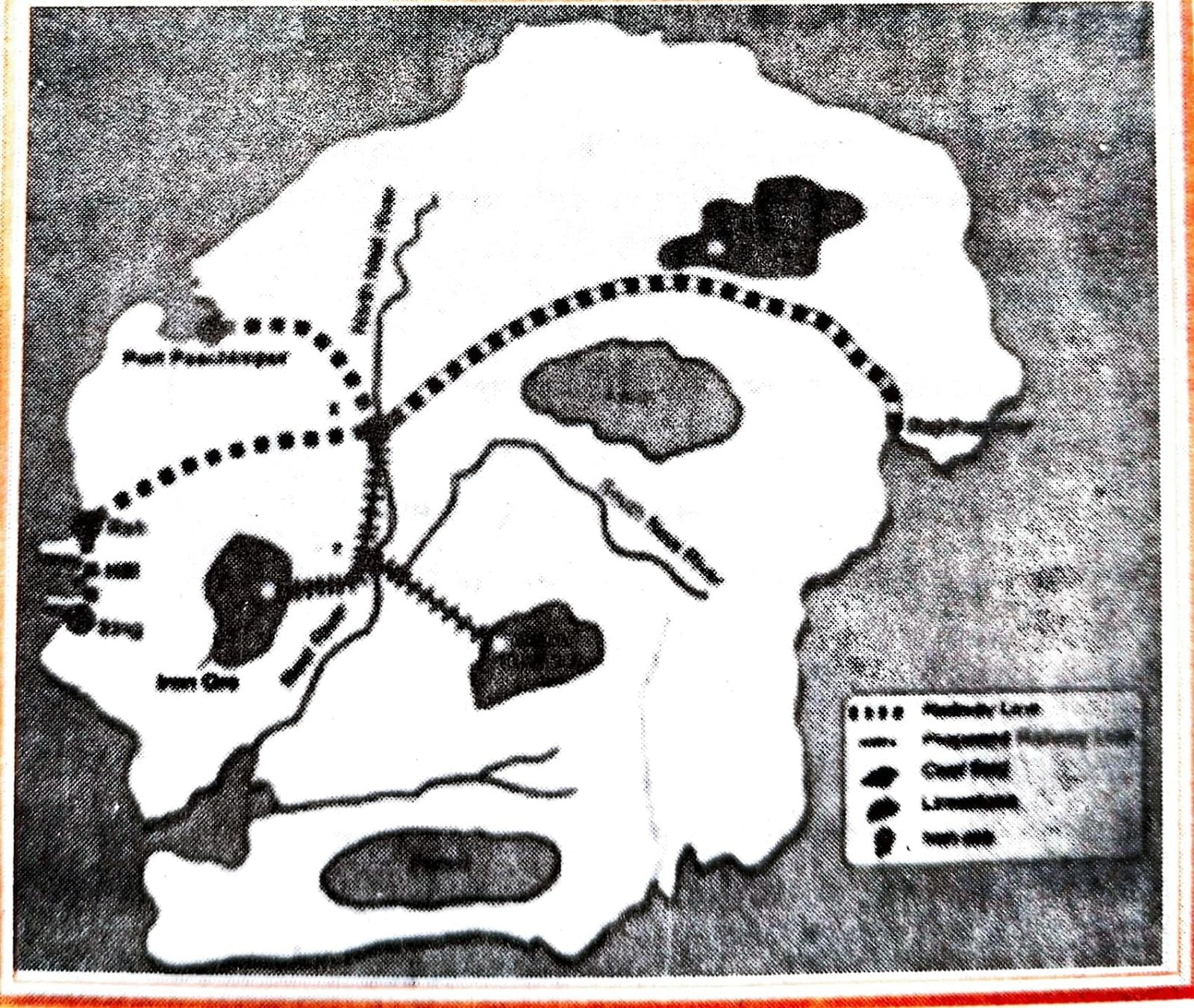
Transportation of the coal is by railway, which is relatively cheap.
3. Limestone: This is widely available over the island, but the purest deposits are in the Chuna mountains.
4. Water: Both the tributaries of river Neel carry sufficient water to supply a large iron and steel plant in all seasons. The sea water, because of its high salt content is unsuitable.
5. Market: It is expected that the chief market for the plant’s products will be the engineering works of Rajdhanipur. Transport costs for the products mainly small steel bars and light steel plates would be relatively low.
6. Labour Supply: This will have to be recruited mainly from the unskilled workers in the 3 fishing villages of Hil, Rah and Sing. It is expected that most workers will commute daily from their present homes.
7. Port Facilities: These are at present minimal. There is a good, deep natural harbour at port Paschimpuri developed to import metal alloys.
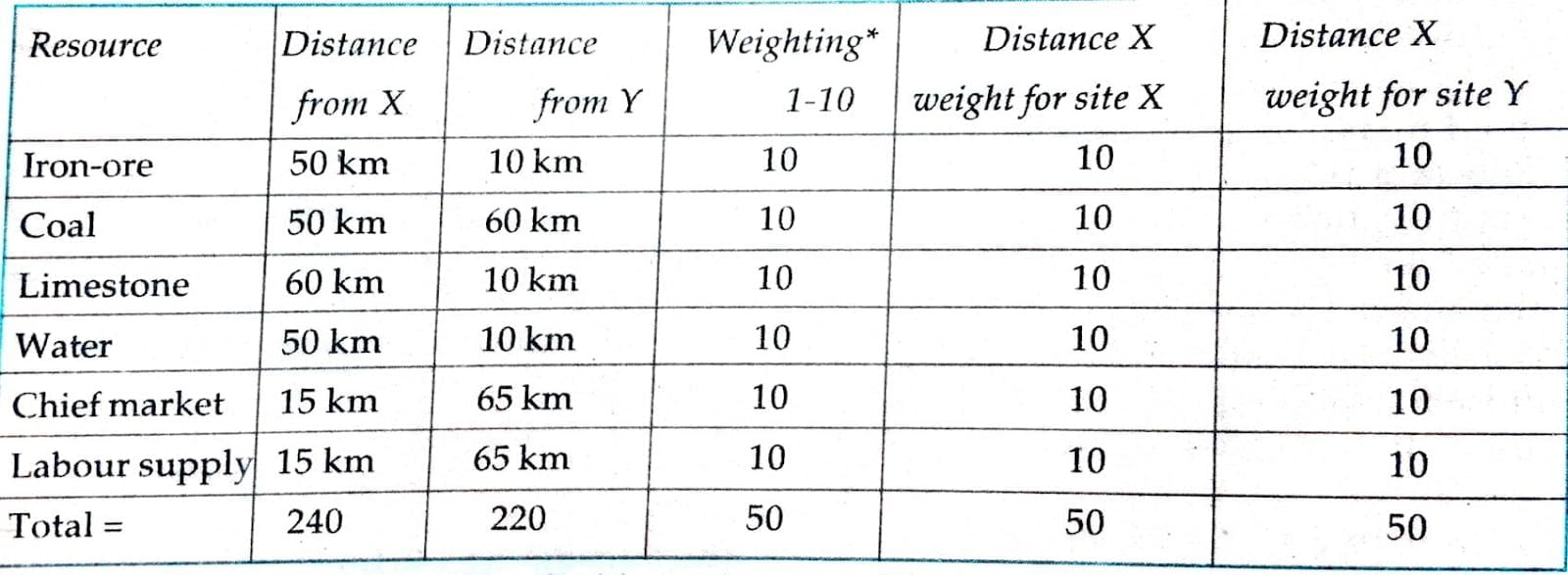
SOME OTHER IMPORTANT QUESTIONS FOR EXAMINATION
VERY SHORT TYPE QUESTIONS ANSWER
Q.1. Name the rivers that provide adequate water supply to steel industry in Pittsburg.
Ans. The Ohio, the Monogahela and Allegheny rivers provide adequate water supply to steel industry in Pittsburgh.
Q.2. Give the full form for TISCO.
Ans. Tata Iron and Steel Company Limited.
Q.3. Where was TISCO started at?
Ans. TISCO was started at Sakchi, Jamshedpur.
Q.4. Name the industries associated with forests.
Ans. Pulp and paper, pharma ceuticals, furniture and buildings.
Q.5. Give two examples of small scale industries.
Ans. Silk weaving, food processing.
Q.6. Name an important centre of steel industry in USA.
Ans. Pittsburgh.
Q.7. Where was the first textile mill established in India?
Ans. The first textile mill was established at Fort Gloster near Mumbai.
Q.8. What is Osaka also known as?
Ans. Osaka is also known as the Manchester of Japan.
Q.9. Name the areas (countries) from where Osaka derives its cotton.
Ans. Egypt, India, China and USA.
SHORT TYPE QUESTIONS ANSWER
Q.1. Name different types of fibres and give examples.
Ans. 1. Natural Fibres: e.g., wool, silk, cotton, linen and jute.
2. Man-made Fibres: e.g., nylon, polyester, acrylic, and rayon.
Q.2. Classify the industries according to size.
Ans. Based on size, industries can be classified as:
(a) Cottage Industry: It is a type of household manufacturing unit in which the members of a single family work in their homes with ordinary tools, to process the raw materials. The raw material is locally obtained and the processed goods have a local market. The main articles made in this industry are food stuffs, pottery, shoes, basket, handloom, jewellery etc.
(b) Small Scale Industry: When a cottage industry starts expanding and begins employing labourers with increased use of machines and power it becomes a small scale industry. Silk weaving and food processing industries are small scale industries.
(c) Large Scale Industry: This industry involves the use of huge machines which operate with power, large number of workers, huge amount of capital investment. Production of automobiles and heavy machinery are large scale industries.
Q.3. The steel industry at Pittsburgh enjoys locational advantages. Give reasons.
Ans. (a) Some of the raw materials such as coal is available locally while the iron ore comes from iron mines at Minnesota, about 1500 km from Pittsburgh.
(b) Between these mines and Pittsburgh is one of the world’s best routes for shipping ore cheaply.
(c) Trains carry the ores from Great Lakes to Pittsburgh.
(d) The Ohio, Monongahela and Allegheny rivers provide adequate water supply.
Q.4. List out the industrial system of production.
Ans. An industrial system consists of inputs, processes and outputs.
The inputs are raw materials, labour, cost of land, transport, power and other infrastructure.
The processes include a wide range of activities that convert raw material into finished products.
The outputs are the finished products and income earned from it.
Q. 5. Ahmedabad textile mills have been having some problems.Give reasons.
Ans. Several textile mills in Ahmedabad have closed down due to emerging of new textile centres in the country as well as non upgradation of machines and technology in mills of Ahmedabad.
Q. 6. Define Manufacturing.
Ans. Change of raw materials into products of more value to the people is referred to as manufacturing.
For example-changing pulp into paper and paper into notebook.
Q. 7. List the physical and human factors of industrial location.
Ans. Physical factors of industrial location includes -land, water, power, raw materials etc.
Human factors of industrial location includes – capital, labour policies, market, technology, transportation, communication etc.
Q. 8. What do you mean by Information Technology?
Ans. The information technology industry deals in the storage, processing and distribution of information through radio, television, cellular phones, computers, laptops etc.
LONG TYPE QUESTIONS ANSWER
Q.1. Ahmedabad is situated in the heart of a cotton growing area. Write its advantages.
Or
Discuss the locational advantages for the development of cotton textile industry in Ahmedabad.
Ans. (a) Location of Ahmedabad ensures easy availability of raw material.
(b) The humid climate is ideal for textile processes.
(c) Easy access to market is provided through transportation by well developed roads and railway network.
(d) The plain area and easy available of land helps establish mills.
(e) The humid climate is also ideal for textile processes.
Q.2. Sakchi was chosen to set up the steel plant for several reasons. Give some of them.
Ans. (a) Sakchi was close to the iron ore, coal and manganese deposits as well as nearness of Kolkata which provided a large market.
(b) It was situated only 32 km away from Kalimati station on the Kolkata Nagpur railway line.
(c) The Kharkai and Subarnarekha rivers running nearby ensured water supply.
(d) TISCO gets coal from Jharia coal fields and iron ore, limestone, dolomite and manganese from Odisha and Chattisgarh.
Q.3. Give risk-reduction measures for an industrial disaster.
Ans. (a) Densely populated residential areas should be separated far away from the industrial areas.
(b) People staying in the vicinity of industries should be aware of the storage of toxins or hazardous substances and their possible effects in case an accident occurs.
(c) Fire warning and fighting system should be improved.
(d) Storage capacity of toxic substances should be limited.
(e) Pollution dispersion qualities in the industries should be checked.
Q.4. Discuss the similarities between Bangalore and Silicon Valley in California.
Ans. (a) Bangalore has the largest number of educational institutions and IT colleges in India while Silicon Valley in California is close to some of the advanced scientific and technological centres in the world.
(b) Bangalore is considered dust free and California supports with a pleasant climate with a clean environment.
(c) Both Bangalore and California have good skilled work force.
Q.5. Describe the importance of cotton textile industry in Osaka.
Or
“Cotton textile industry developed in Osaka due to several geographical factors”. Explain the statement.
Ans. Osaka is an important textile centre of Japan, also known as the Manchester of Japan.
The textile industry developed in Osaka due to several geographical factors. Some of these are:
(a) The extensive plain around Osaka ensured that land was easily available for the growth of cotton mills.
(b) Warm, humid climate is well suited to spinning and weaving.
(c) The river Yodo provides sufficient water for the mills.
(d) Labour is easily available.
(e) Location of port facilitates, import of raw cotton and for exporting textiles.
HIGHER ORDER THINKING SKILL QUESTIONS
Q.1. Why is Bangalore called Silicon Valley of India?
Ans. Bangalore is called Silicon Valley of India because:
(a) It is the base of India’s space program.
(b) It has the highest number of software companies including MNCs.
(c) It has been ranked as world’s fourth best global hub of technological innovations by United Nations.
Q.2. What does ‘Being Bangalored’ mean?
Ans. Being Bangalored’ means to lose one’s job to someone in the city of Bangalore. A few years ago many IT jobs in the USA were outsourced to countries like India where equally skilled labour was available at lower salaries.
Q. 3. What are Industrial regions? Name the major industrial regions of the world and India.
Ans. Industrial region means when a number of industries locate close to each other and share the benefits of their closeness.
Major industrial regions of the world are:
(a) Eastern North America.
(b) Western and Central Europe.
(c) Eastern Europe.
(d) Eastern Asia.
Major Industrial regions of India are:
(a) Mumbai – Pue cluster.
(b) Banglore – Tamil Nadu region.
(c) Hugli Region.
(d) Vishakhapatnam – Guntur belt.
(e) Ahmedabad – Barwda Region.
Q. 4. Why traditional cotton textile industry could not face competition from the new textile mills of the west?
Ans. Traditional cotton textile industry could not face competition from the new textile mills of the west because the production of hand woven cotton textile was expensive and time consuming.
Q. 5. Classify the industries on the basis of ownership.
Ans. On the basis of ownership, industries can be classified unit and categories:
(a) Private Sector Industries: These industries are owned and operated by individuals or a group of individuals e.g., – Reliance.
(b) Public Sector Industries: These industries are owned and operated by the government. e.g., Hindustan Aeronautics Limited and Steel Authority of India Limited.
(c) Joint Sector Industries: These industries are owned and operated by the state and individuals or a group of individuals e.g., Maruti Udyog Limited.
(d) Co-operative Industries: These industries are owned and operated by the producers or suppliers of raw materials, workers or both. e.g., Anand milk Union limited, Sudha Diary.
VALUE BASED QUESTIONS
Q. 1. “Value is added to substances with the help of industries.” How?
Ans. Industries add value to the substances as raw material after processed is converted into useful goods by different means. This measured their value in the market.
Q. 2. Explain the factors favourable for the development of IT industry in Bengaluru.
Ans. IT industry developed in Bengaluru because of the following locational advantages:
(a) Bengaluru has the largest number of educational institutions and IT colleges in India.
(b) The city was considered dust free with low rents and low cost of living.
(c) The State government of Karnataka was the first to announce an IT policy in 1992.
(d) The city has the largest and widest availability of skilled managers with work experience.
MAP QUESTIONS
1. On the map of the world mark and locate the major industrial regions.
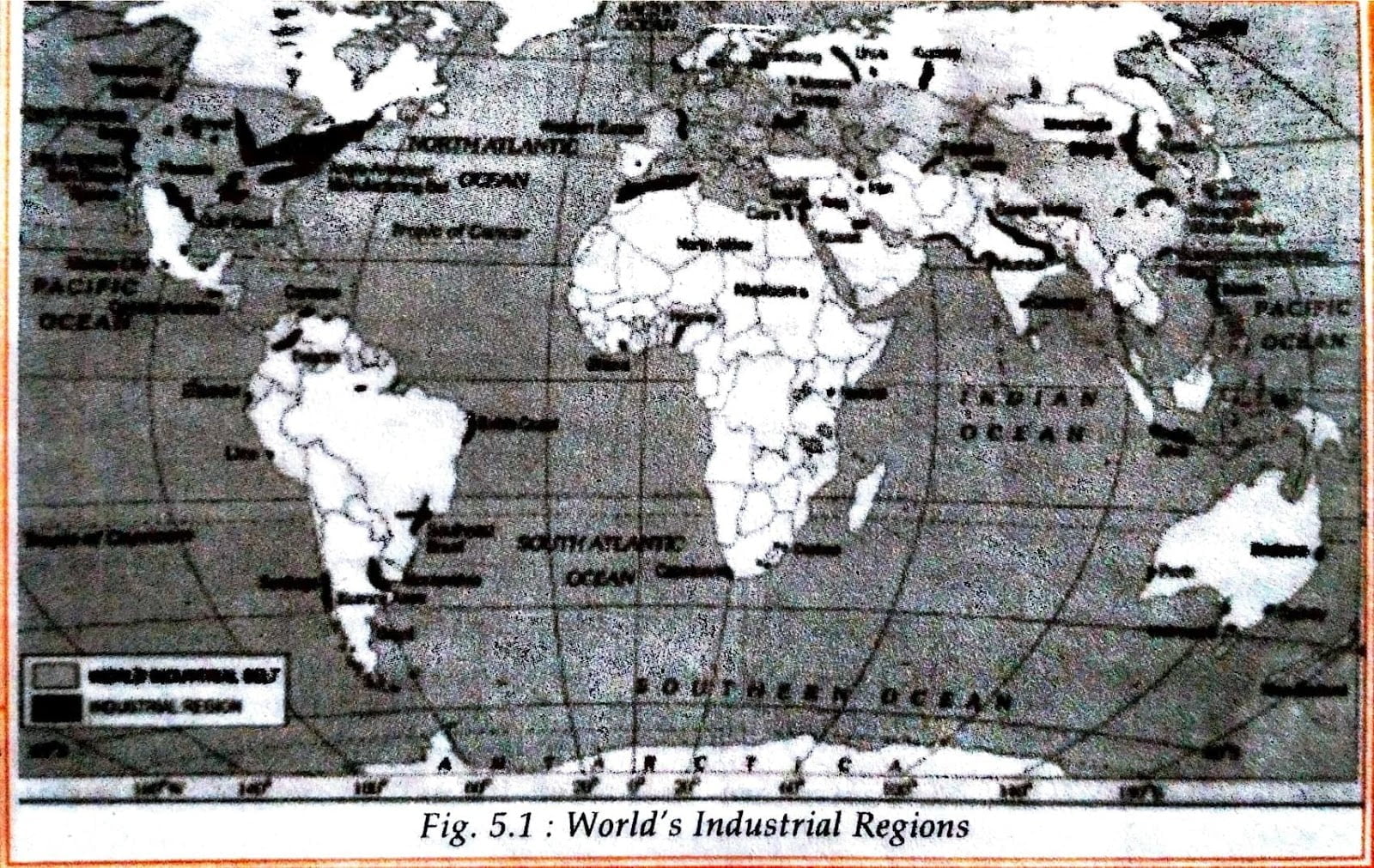
2. On the map of world mark and locate world’s iron ore producing areas.
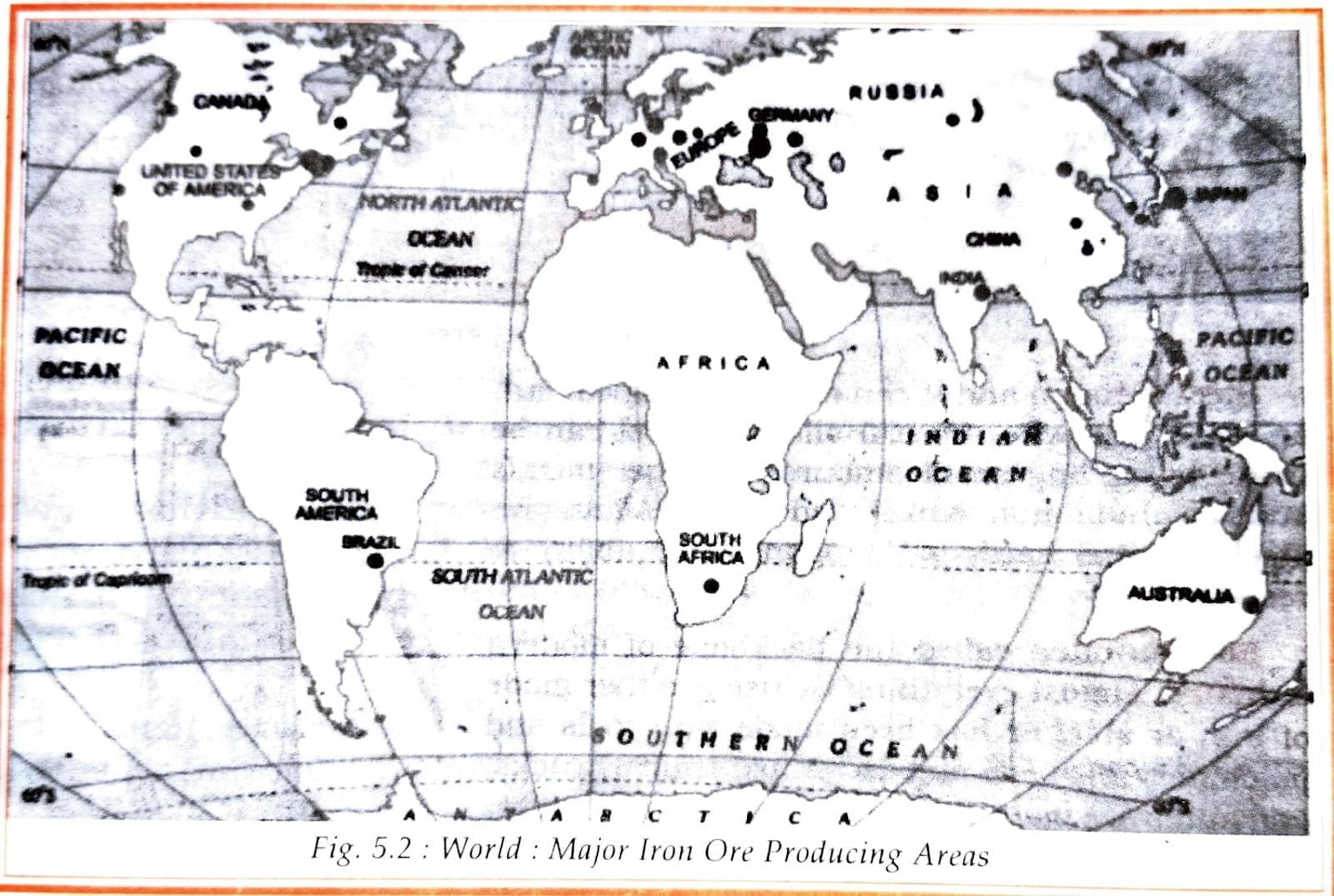
3. On the given map of world mark and locate world cotton textile industries.
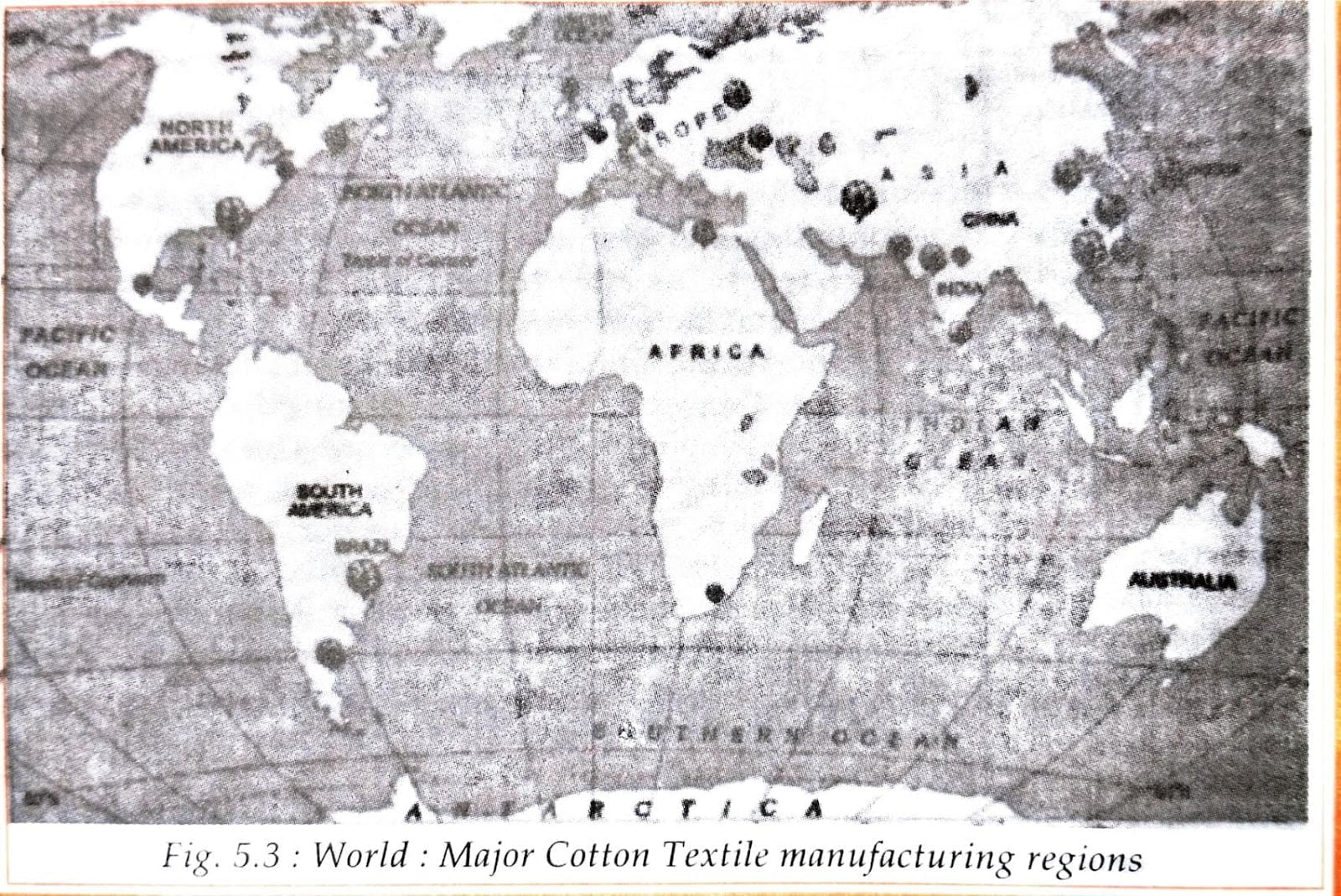
OBJECTIVE TYPE QUESTIONS
Multiple Choice Questions
1. Name an industry that is a service provider.
(a) Coal mining.
(b) Tourism.
(c) Manufacturing fish oil.
(d) Basket weaving.
Ans. (b) Tourism.
2. What forms a large scale industry?
(a) Pharmaceuticals.
(b) Production of automobiles.
(c) HAL.
(d) Basket weaving.
Ans. (b) Production of automobiles.
3. The cotton textile of Masulipatnam is known as
(a) Chintzes.
(b) Calicos.
(c) Muslin.
(d) Cotton.
Ans. (a) Chintzes.
4. Which of the following is a output of iron and steel industry?
(a) Pig iron.
(b) Iron ore.
(c) Steel.
(d) All of these.
Ans. (c) Steel.
5. Which of the following class of economic activities does manufacturing come under?
(a) Primary.
(b) Secondary.
(c) Tertiary.
(d) None of these.
Ans. (b) Secondary.
6. Which of the following states has some major producing steel centres?
(a) Tanil Nadu.
(b) Jharkhand.
(c) Punjab.
(d) Maharashtra.
Ans. (b) Jharkhand.
7. The river ____________ provides sufficient water to Osaka mills.
(a) Ohio.
(b) Yodo.
(c) Allegheny.
(d) Ganga.
Ans. (c) Allegheny.
II. Fill in the blanks:
1. ____________ is often called the backbone of modern industry.
Ans. Steel.
2. ____________ In several other industrial plants were set up after TISCO.
Ans. Jamshedpur.
3. Silicon Valley is located in _____________.
Ans. California.
4. Densely populated residential areas should be separated far away from the ____________ areas.
Ans. Industrial.
5. _____________ dispersion qualities in the industries should be improved.
Ans. Pollution.
6. _____________ give steel unusual hardness, toughness or availability to resist rust.
Ans. Alloys.
7. Silicon Valley is a part of _____________ Valley.
Ans. Santa Clara.

Hi! my Name is Parimal Roy. I have completed my Bachelor’s degree in Philosophy (B.A.) from Silapathar General College. Currently, I am working as an HR Manager at Dev Library. It is a website that provides study materials for students from Class 3 to 12, including SCERT and NCERT notes. It also offers resources for BA, B.Com, B.Sc, and Computer Science, along with postgraduate notes. Besides study materials, the website has novels, eBooks, health and finance articles, biographies, quotes, and more.



